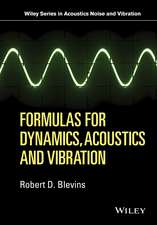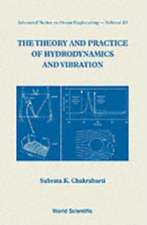Digital Sound Synthesis by Physical Modeling Using the Functional Transformation Method
Autor Lutz Trautmann, Rudolf Rabensteinen Limba Engleză Paperback – 14 sep 2012
| Toate formatele și edițiile | Preț | Express |
|---|---|---|
| Paperback (1) | 638.43 lei 6-8 săpt. | |
| Springer Us – 14 sep 2012 | 638.43 lei 6-8 săpt. | |
| Hardback (1) | 645.79 lei 6-8 săpt. | |
| Springer Us – 31 oct 2003 | 645.79 lei 6-8 săpt. |
Preț: 638.43 lei
Preț vechi: 751.10 lei
-15% Nou
Puncte Express: 958
Preț estimativ în valută:
122.17€ • 130.64$ • 101.86£
122.17€ • 130.64$ • 101.86£
Carte tipărită la comandă
Livrare economică 18 aprilie-02 mai
Preluare comenzi: 021 569.72.76
Specificații
ISBN-13: 9781461349006
ISBN-10: 1461349001
Pagini: 256
Ilustrații: XXVI, 226 p.
Dimensiuni: 155 x 235 x 13 mm
Greutate: 0.36 kg
Ediția:Softcover reprint of the original 1st ed. 2003
Editura: Springer Us
Colecția Springer
Locul publicării:New York, NY, United States
ISBN-10: 1461349001
Pagini: 256
Ilustrații: XXVI, 226 p.
Dimensiuni: 155 x 235 x 13 mm
Greutate: 0.36 kg
Ediția:Softcover reprint of the original 1st ed. 2003
Editura: Springer Us
Colecția Springer
Locul publicării:New York, NY, United States
Public țintă
ResearchCuprins
1. Introduction.- 2. Sound-Based Synthesis Methods.- 1 Wavetable synthesis.- 2 Granular synthesis.- 3 Additive synthesis.- 4 Subtractive synthesis.- 5 FM synthesis.- 6 Combinations of sound-based synthesis methods.- 3. Physical Description of Musical instruments.- 1 General notation.- 2 Subdivision of a musical instrument into vibration generators and a resonant body.- 3 Physical description of string vibrations.- 4 Physical description of membrane vibrations.- 5 Physical description of resonant bodies.- 6 Chapter summary.- 4. Classical Synthesis Methods Based on Physical Models.- 1 Finite difference method.- 2 Digital waveguide method.- 3 Modal synthesis.- 4 Chapter summary.- 5. Functional Transformation Method.- 1 Fundamental principles of the FTM.- 2 Application of the FTM to vibrating strings.- 3 Application of the FTM to vibrating membranes.- 4 Application of the FTM to resonant bodies.- 5 Chapter summary.- 6. Comparison of the Ftm with the Classical Physical Modeling Methods.- 1 Comparison of the FTM with the FDM.- 2 Comparison and combination of the FTM with the DWG.- 3 Comparison of the FTM with the MS.- 4 Chapter conclusions.- 7. Summary, Conclusions, and Outlook.
Recenzii
From the reviews:
"This is a book devoted to digital sound synthesis (DSS). The exposition makes full use of modern mathematical tools. … The book represents an interesting contribution to music synthesis and the reviewer thinks it will soon become a reference volume in the electric and mechanical domains." (D. Stanomir, Mathematical Reviews, 2005 b)
"This book … gives not only a thorough introduction to the Functional Transformation Method itself, but provides an excellent overview of existing alternatives. … The book is exemplary in clarity as well as for references and lists of symbols, variables, abbreviations, etc. More than fifty figures are included. … an innovative and far-reaching text that should find its way to all institutes where sound synthesis is taught or researched." (K. Guettler, Acta Acustica united with Acustica, Vol. 91 (4), 2005)
"This is a book devoted to digital sound synthesis (DSS). The exposition makes full use of modern mathematical tools. … The book represents an interesting contribution to music synthesis and the reviewer thinks it will soon become a reference volume in the electric and mechanical domains." (D. Stanomir, Mathematical Reviews, 2005 b)
"This book … gives not only a thorough introduction to the Functional Transformation Method itself, but provides an excellent overview of existing alternatives. … The book is exemplary in clarity as well as for references and lists of symbols, variables, abbreviations, etc. More than fifty figures are included. … an innovative and far-reaching text that should find its way to all institutes where sound synthesis is taught or researched." (K. Guettler, Acta Acustica united with Acustica, Vol. 91 (4), 2005)














